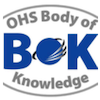Chapter 17.3: Dusts, Fumes & Fibres
Abstract
Dusts, fumes and fibres have been part of many workplaces since ancient times. The longevity of the problem does not mean that it is necessarily well controlled in present-day workplaces. Indeed, in recent times, we have seen the resurgence of well-known diseases linked to exposure to dust, fumes and fibres. While some aspects of the identification, evaluation and control of these hazards require specialist expertise, generalist OHS professionals have a key role to play in ensuring the health and safety of workers potentially exposed. This chapter is one in a suite of four OHS Body of Knowledge chapters addressing chemical hazards. It provides insight into how dusts, fumes and fibres impact the health of workers and how exposures may be evaluated and controlled. It supports OHS professionals in applying a collaborative approach to the management of dust, fumes and fibres, calling on specialist expertise as appropriate.
Keywords
Dust, fume, fibre, aerosols, air monitoring, airborne contaminant, exposure assessment, health, occupational hygiene, particles, risk management, toxicity
Current Version: 2023
Chapter 17.3: Dusts, Fumes & Fibres
Table of contents
| 1 | Introduction |
| 1.1 | Terminology and definitions |
| 2 | Historical perspective |
| 3 | Extent of the problem |
| 4 | Exposure |
| 4.1 | Respiratory tract particle deposition and clearance |
| 4.2 | Responses to exposure |
| 5 | Legislation and standards |
| 5.1 | Occupational exposure limits |
| 6 | Risk assessment |
| 6.1 | Exposure assessment strategies |
| 6.2 | Air monitoring |
| 6.3 | Health monitoring |
| 7 | Prevention and control |
| 7.1 | DFF risk control resources |
| 7.2 | DFF Controls |
| 7.3 | Case Study |
| 8 | Emerging issues |
| 9 | Implications for OHS practice |
| 10 | Summary |
Useful resources
References
Linda Apthorpe
MScOHP, FAIOH, Certified Occupational Hygienist (COH)®, MFAMANZ Occupational Hygienist / Lecturer
Linda has more than 25 years’ experience providing consulting and laboratory services to a wide variety of workplaces. She has a strong background in analysis and control of workplace hazards such as asbestos, dust and silica. Linda has authored papers and textbook chapters on occupational hygiene and facilitated professional development seminars and training courses on asbestos, silica and occupational hygiene.
Shahnaz Bakand
BSc (OccHealth), MSc (OccHyg), PhD Honorary Senior Lecturer
Shahnaz has worked as an OHS educator and multidisciplinary researcher in Australia and overseas for 30 years. Her PhD research was awarded an Australian Museum Eureka Prize in 2006. As an expert in toxicology and nanotoxicology, Shahnaz has collaborated with the World Health Organisation on guidelines for nanomaterials, with her work resulting in policy changes at an international level.
Jennifer Hines
BSc (Hons), GDipOH, MScOHP, PhD, FAIOH, Certified Occupational Hygienist (COH)®
Occupational Hygienist/Lecturer
Jennifer has more than 20 years’ experience in improving workplaces for workers. She has worked extensively in heavy industry, including alumina refining, copper refining and smelting, and underground coal mining. Jennifer is the Director of EHS Solutions and combines consultancy with academia to encourage others into the world of occupational hygiene.
Leanne Treadwell
BEChem (Hons), MEA, MAIHS
Lecturer
Leanne graduated as a chemical engineer and has worked as an OHS professional in industry and government for more than 35 years in a range of roles in OHS, risk and business management, IT and aged care. She has specialised skills in process safety, major hazard facilities, emergency preparedness and response, and security. Currently, Leanne teaches postgraduate OHS at UOW.
Jane L. Whitelaw
MAppSc, GDipOHS, FAIOH, Certified Occupational Hygienist (COH)®, CIH®
Occupational Hygienist / OHS Academic Program Director
Jane had more than 25 years’ experience in corporate OHS roles in heavy manufacturing industries before joining UOW in 2009, where she is OHS Academic Program Director and a PhD candidate in the Faculty of Medicine. Jane is a quantitative researcher whose primary area of research is the evaluation of controls for prevention of occupational diseases, with a focus on respiratory illnesses.
Chapter 17.3: Dusts, Fumes & Fibres
Learning Outcomes:
The OHS Body of Knowledge takes a conceptual approach which enables it to be applied in different contexts and frameworks.
To optimise its value for education and professional development learning outcomes have been developed for each technical chapter in the Body of Knowledge.
The learning outcomes as described give an indication of what should be the capabilities of an OHS professional; it is up to those developing OHS education programs, OHS professionals planning their CPD or recruiters or employers selecting or developing people for the OHS function to consider the required breadth vs. depth .
Please read the section on using the learning outcomes before delving into the leaning outcomes of the individual chapters.






